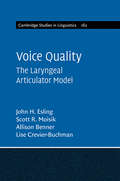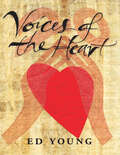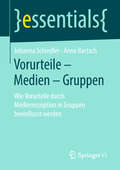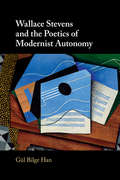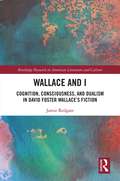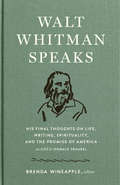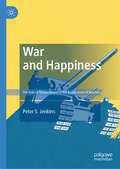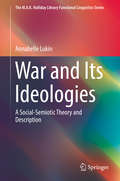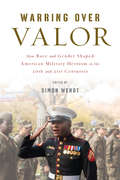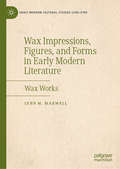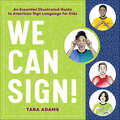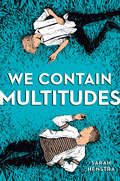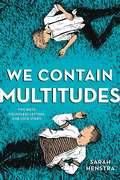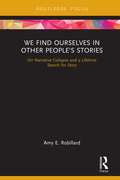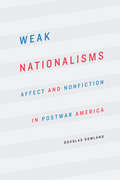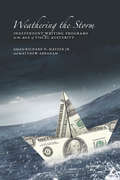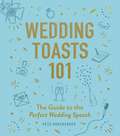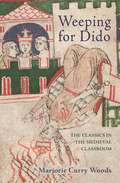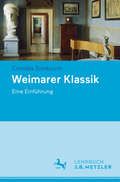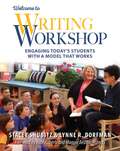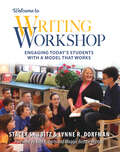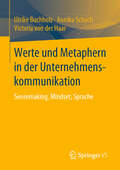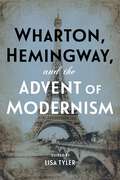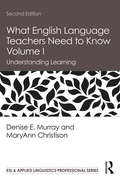- Table View
- List View
Vocabulary Spelling Poetry III
by James A. ChapmanThis teacher's key accompanies the sold-separately Vocabulary, Spelling & Poetry III and contains a copy of the student text with answers and a sentence bank for vocabulary and spelling words.
Voice Quality: The Laryngeal Articulator Model (Cambridge Studies in Linguistics #162)
by John H. Esling Scott R. Moisik Allison Benner Lise Crevier-BuchmanThe first description of voice quality production in forty years, this book provides a new framework for its study: The Laryngeal Articulator Model. Informed by instrumental examinations of the laryngeal articulatory mechanism, it revises our understanding of articulatory postures to explain the actions, vibrations and resonances generated in the epilarynx and pharynx. It focuses on the long-term auditory-articulatory component of accent in the languages of the world, explaining how voice quality relates to segmental and syllabic sounds. Phonetic illustrations of phonation types and of laryngeal and oral vocal tract articulatory postures are provided. Extensive video and audio material is available on a companion website. The book presents computational simulations, the laryngeal and voice quality foundations of infant speech acquisition, speech/voice disorders and surgeries that entail compensatory laryngeal articulator adjustment, and an exploration of the role of voice quality in sound change and of the larynx in the evolution of speech.
Voices of the Heart
by Ed YoungIn this deeply personal book, artist and author Ed Young explores twenty-six Chinese characters, each describing a feeling or emotion, and each containing somewhere the symbol for the heart. Through stunning collage art that interprets the visual elements within each character, Young uncovers layers of emotional meaning for words such as joy and sorrow, respect and rudeness. He invites children to probe the full range of their own emotions, and gives parents, librarians, and older readers a context for discussing ethics and for examining the silmilarities and differences between old and new, East and West. Voices of the Heart is a truly unique exploration—or as Young writes, "adventure"—into the different moods, and dangers and abilities of the human heart.
Vorurteile – Medien – Gruppen: Wie Vorurteile durch Medienrezeption in Gruppen beeinflusst werden (essentials)
by Johanna Schindler Anne BartschIm Alltag haben viele Menschen fast ausschließlich über Medieninhalte Kontakt zu Angehörigen verschiedener anderer gesellschaftlicher Gruppen (Outgroups). Gleichzeitig nutzen und verarbeiten sie Medieninhalte häufig gemeinsam in ihrer eigenen Gruppe (Ingroup). Johanna Schindler und Anne Bartsch beleuchten den Einfluss der Medienrezeption in Kleingruppen auf Vorurteile gegenüber Outgroups. Dazu systematisieren sie wissenschaftliche Erkenntnisse zu Vorurteilen und zur Medienrezeption in Gruppen und verbinden diese miteinander. Außerdem stellen die Autorinnen die Ergebnisse einer explorativen Feldstudie vor. Auf diese Weise wird eine integrative Perspektive auf Gruppenphänomene in der modernen Mediengesellschaft ermöglicht.Die AutorinnenJohanna Schindler ist wissenschaftliche Mitarbeiterin am Institut für Kommunikationswissenschaft und Medienforschung der Ludwig-Maximilians-Universität München. Prof. Dr. Anne Bartsch ist Professorin für Empirische Kommunikations- und Medienwissenschaft am IfKMW der Universität Leipzig.
Wallace Stevens and the Poetics of Modernist Autonomy
by Gül Bilge HanWallace Stevens and the Poetics of Modernist Autonomy presents a rethinking of modernist claims to autonomy by focusing on the work of Wallace Stevens, one of the most renowned poets of the twentieth century. By showing how multiple socio-political currents underlie and motivate Stevens' version of autonomy, the book challenges the commonly received accounts of the term as art and literature's escape from the world. It provides new and close readings of Stevens' work including poems from different stages of the poet's career. It re-energizes a tradition of historicist readings of Stevens from the 1980s and 1990s. The study of Stevens' work in this book is developed in constant dialogue with current studies in modernism and aesthetic theory, particularly those offered by Jacques Rancière and Alain Badiou. The book explores the question of autonomy in Stevens' exploration of the aesthetic and social domains, and the vexed issue of his poetry's relation to philosophical thinking.
Wallace and I: Cognition, Consciousness, and Dualism in David Foster Wallace’s Fiction (Routledge Research in American Literature and Culture)
by Jamie RedgateThough David Foster Wallace is well known for declaring that "Fiction’s about what it is to be a fucking human being," what he actually meant by the term "human being" has been quite forgotten. It is a truism in Wallace studies that Wallace was a posthumanist writer, and too theoretically sophisticated to write about characters as having some kind of essential interior self or soul. Though the contemporary, posthuman model of the embodied brain is central to Wallace’s work, so is his critique of that model: the soul is as vital a part of Wallace’s fiction as the bodies in which his souls are housed. Drawing on Wallace’s reading in the science and philosophy of mind, this book gives a rigorous account of Wallace’s dualism, and of his humanistic engagement with key postmodern concerns: authorship; the self and interiority; madness and mind doctors; and free will. If Wallace’s fiction is about what it is to be a human being, this book is about the human ‘I’ at the heart of Wallace’s work.
Walt Whitman Speaks: A Library of America Special Publication
by Walt WhitmanFor the Whitman bicentennial, a delightful keepsake edition of the incomparable wisdom of America's greatest poet, distilled from his fascinating late-in-life conversations with Horace Traubel.Toward the end of his life, Walt Whitman was visited almost daily at his home in Camden, New Jersey, by the young poet and social reformer Horace Traubel. After each visit, Traubel meticulously recorded their conversation, transcribing with such sensitivity that Whitman’s friend John Burroughs remarked that he felt he could almost hear the poet breathing. In Walt Whitman Speaks, acclaimed author Brenda Wineapple draws from Traubel’s extensive interviews an extraordinary gathering of Whitman’s observations that conveys the core of his ethos and vision. Here is Whitman the sage, champion of expansiveness and human freedom. Here, too, is the poet’s more personal side—his vivid memories of Thoreau, Emerson, and Lincoln, his literary judgments on writers such as Shakespeare, Goethe, and Tolstoy, and his expressions of hope in the democratic promise of the nation he loved. The result is a keepsake edition to touch the soul, capturing the distilled wisdom of America’s greatest poet.
War and Happiness: The Role of Temperament in the Assessment of Resolve
by Peter S. Jenkins“Jenkins’ rare combination of psychological theorizing and archival research in several countries and time periods yields a fascinating new take on the central question of when states over-estimate or under-estimate others’ resolve. The biases that leaders and elites fall prey to appear to vary with their emotional states and senses of well-being, factors that most scholars have ignored.”—Robert Jervis, author of How Statesmen ThinkThis groundbreaking book explains how the happiness levels of leaders, politicians and diplomats affect their assessments of the resolve of their state’s adversaries and allies. Its innovative methodology includes case studies of the origins of twelve wars with Anglo-American involvement from 1853 to 2003 and the psycholinguistic text mining of the British Hansard and the U.S. Congressional Record.
War and Its Ideologies: A Social-Semiotic Theory and Description (The M.A.K. Halliday Library Functional Linguistics Series)
by Annabelle LukinIdeology is so powerful it makes us believe that war is rational, despite both its brutal means and its devastating ends. The power of ideology comes from its intimate relation to language: ideology recruits all semiotic modalities, but language is its engine-room. Drawing on Halliday’s linguistic theory – in particular, his account of the “semiotic big-bang” - this book explains the latent semiotic machinery of language on which ideology depends. The book illustrates the ideological power of language through a study of perhaps the most significant and consequential of our ideologies: those that enable us to legitimate, celebrate, even venerate war, at the same time that we abhor, denounce and proscribe violence. To do so, it makes use of large multi-register corpora (including the British National Corpus), and the reporting of the 2003 invasion of Iraq by Australian, US, European, and Asian news sources. Combining detailed text analysis with corpus linguistic methods, it provides an empirical analysis showing the astonishing reach of our ideologies of war and their profoundly covert and coercive power.
Warring over Valor: How Race and Gender Shaped American Military Heroism in the Twentieth and Twenty-First Centuries (War Culture)
by Steve Estes Ellen D. Wu Simon Hall Matthias Voigt Simon Wendt George Lewis Amy Lucker Sarah Makeschin Sonja John Carrie AndersenBy focusing on how the idea of heroism on the battlefield helped construct, perpetuate, and challenge racial and gender hierarchies in the United States between World War I and the present, Warring over Valor provides fresh perspectives on the history of American military heroism. The book offers two major insights into the history of military heroism. First, it reveals a precarious ambiguity in the efforts of minorities such as African Americans, Asian Americans, Native Americans, women, and gay men to be recognized as heroic soldiers. Paradoxically, America’s heroism discourse allowed them to press their case for full membership in the nation, but doing so simultaneously validated the dichotomous interpretations of race and gender they repudiated. The ambiguous role of marginalized groups in war-related hero-making processes also testifies to this volume’s second general insight: the durability and tenacity of the masculine warrior hero in U.S. society and culture. Warring over Valor bridges a gap in the historiography of heroism and military affairs.
Wax Impressions, Figures, and Forms in Early Modern Literature: Wax Works (Early Modern Cultural Studies 1500–1700)
by Lynn M. MaxwellThis book explores the role of wax as an important conceptual material used to work out the nature and limits of the early modern human. By surveying the use of wax in early modern cultural spaces such as the stage and the artist’s studio and in literary and philosophical texts, including those by William Shakespeare, John Donne, René Descartes, Margaret Cavendish, and Edmund Spenser, this book shows that wax is a flexible material employed to define, explore, and problematize a wide variety of early modern relations including the relationship of man and God, man and woman, mind and the world, and man and machine.
We Can Sign!: An Essential Illustrated Guide to American Sign Language for Kids
by Tara AdamsEasy signing is in your hands—an illustrated guide for kids ages 8 to 12Discover how simple learning sign language for kids can be! Whether it's for reaching out to a Deaf person, chatting with friends across a crowded room, or just learning an amazing new language, We Can Sign! is an essential guide to getting started with American Sign Language for kids.Bursting with almost 200 fully-illustrated signs, memory tips, and more, this instructional aid for sign language for kids makes mastering ASL easy. Ten chapters take you all the way from sign language basics and conversation phrases to must-have vocab. Get signing today!We Can Sign! An Essential Illustrated Guide to American Sign Language for Kids includes:Up-to-date info—Learn the most modern version of American Sign Language—while also getting fun insight into Deaf culture.Clear illustrations—Start signing fast with detailed drawings that show exactly how each sign should look.182 signs you need—Lessons begin simple and progress to more advanced ideas as you learn words and phrases that are perfect for use in a variety of situations.Get a helping hand with this fully illustrated guide to sign language for kids!
We Contain Multitudes
by Sarah HenstraAn exhilarating and emotional LGBTQ story about the growing relationship between two teen boys, told through the letters written to one another. For fans of Aristotle and Dante Discover the Secrets of the Universe and I’ll Give You the Sun. <P><P>Thrown together by a zealous English teacher's classroom-mailbox assignment, notorious scrapper, Adam "Kurl" Kurlansky, and Jonathan Hopkirk, a flamboyant Walt Whitman wannabe, have to write an old-fashioned letter to each other every week. <P><P>Kurl is a senior, an ex high school football player, held back a year, while Jo is a nerdy, out tenth grader with a penchant for vintage clothes and a deep love for poetry. They are an unlikely pair, but with each letter, the two begin to develop a friendship that grows into love. <P><P>But with homophobia, bullying and familial abuse, Jonathan and Kurl must struggle to overcome their conflicts and hold onto their relationship, and each other.
We Contain Multitudes
by Sarah HenstraAristotle and Dante Discover the Secrets of the Universe meets I'll Give You the Sun in an exhilarating and emotional novel about the growing relationship between two teenage boys, told through the letters they write to one another. Jonathan Hopkirk and Adam "Kurl" Kurlansky are partnered in English class, writing letters to one another in a weekly pen pal assignment. With each letter, the two begin to develop a friendship that eventually grows into love. But with homophobia, bullying, and devastating family secrets, Jonathan and Kurl struggle to overcome their conflicts and hold onto their relationship...and each other.This rare and special novel celebrates love and life with engaging characters and stunning language, making it perfect for fans of Jandy Nelson, Nina LaCour, and David Levithan.
We Find Ourselves in Other People’s Stories: On Narrative Collapse and a Lifetime Search for Story
by Amy E. RobillardWe Find Ourselves in Other People’s Stories: On Narrative Collapse and a Lifetime Search for Story is a collection of five essays that dissolves the boundary between personal writing and academic writing, a longstanding binary construct in the discipline of composition and writing studies, in order to examine the rhetorical effects of narrative collapse on the stories we tell about ourselves and others. Taken together, the essays theorize the relationships between language and violence, between narrative and dementia, between genre and certainty, and between writing and life.
Weak Nationalisms: Affect and Nonfiction in Postwar America
by Douglas DowlandThe question “What is America?” has taken on new urgency. Weak Nationalisms explores the emotional dynamics behind that question by examining how a range of authors have attempted to answer it through nonfiction since the Second World War, revealing the complex and dynamic ways in which affects shape the literary construction of everyday experience in the United States. Douglas Dowland studies these attempts to define the nation in an eclectic selection of texts from writers such as Simone de Beauvoir, John Steinbeck, Charles Kuralt, Jane Smiley, and Sarah Vowell. Each of these texts makes use of synecdoche, and Weak Nationalisms shows how this rhetorical technique is variously driven by affects including curiosity, discontent, hopefulness, and incredulity. In exploring the function of synecdoche in the creative construction of the United States, Dowland draws attention to the evocative politics and literary richness of nationalism and connects critical literary practices to broader discussions involving affect theory and cultural representation.
Weathering the Storm: Independent Writing Programs in the Age of Fiscal Austerity
by Matthew Abraham Richard N. MatzenWeathering the Storm assesses the socioeconomic and political conditions that have surrounded the rise of independent writing programs (IWPs) and departments. Chapter contributors look at the institutional conditions and challenges that IWPs have faced since the 1980s with a focus on enduring the financial collapse of 2008. Leading writing specialists at the University of Texas at Austin, Syracuse University, the University of Minnesota, and many other institutions document and think carefully about the on-the-ground obstacles that have made the creation of IWPs unique. From institutional naysayers in English departments to skeptical administrators, IWPs and the faculty within them have surmounted not only negative economics but also negative rhetorics. This collection charts the story of this journey as writing faculty continually make the case for the importance of writing in the university curriculum. Independence has, for the most part, allowed IWPs to better respond to the Great Recession, but to do so they have had to define writing studies in relation to other disciplines and departments. Weathering the Storm will be of great interest to faculty and graduate students in rhetoric and composition, writing program administrators, and writing studies and English department faculty. Contributors: Linda Adler-Kassner, Lois Agnew, Alice Batt, David Beard, Davida Charney, Amy Clements, Diane Davis, Frank Gaughan, Heidi Skurat Harris, George H. Jensen, Rodger LeGrand, Drew M. Loewe, Mark Garrett Longaker, Cindy Moore, Peggy O’Neill, Chongwon Park, Louise Wetherbee Phelps, Mary Rist, Valerie Ross, John J Ruszkiewicz, Eileen E. Schell, Madeleine Sorapure, Chris Thaiss, Patrick Wehner, Jamie White-Farnham, Carl Whithaus, Traci A. Zimmerman
Wedding Toasts 101: The Guide to the Perfect Wedding Speech
by Pete HonsbergerWrite and present a memorable wedding toast with this light-hearted, humorous guide that gives you all the tools you&’ll need for a successful speech—the perfect gift for any best man or maid of honor. As much as it&’s an honor to be chosen as the best man or maid of honor at a wedding, giving the perfect speech can sometimes be nerve-wracking. Delivering a crowd-pleasing toast at the reception that has the right amount of humor and sentimentality is a daunting undertaking, no matter how advanced your public speaking skills are. Pete Honsberger&’s guide to giving the perfect wedding toast provides even the most nervous of public speakers with all the tools and advice they need for writing and presenting the best toast ever. After witnessing speeches both good and bad, Honsberger shares a few bits of wisdom he&’s learned along the way, providing building blocks to creating an unforgettable story along with helpful speech prompts, and the perfect checklist that will turn a potentially scary obligation into a golden opportunity. Wedding Toasts 101 presents a fun and simple way to write a successful wedding toast without all the stress so you can spend less time worrying and more time celebrating the happy couple.
Weeping for Dido: The Classics in the Medieval Classroom (E. H. Gombrich Lecture Ser. #1)
by Marjorie Curry WoodsSaint Augustine famously “wept for Dido, who killed herself by the sword,” and many later medieval schoolboys were taught to respond in similarly emotional ways to the pain of female characters in Virgil’s Aeneid and other classical texts. In Weeping for Dido, Marjorie Curry Woods takes readers into the medieval classroom, where boys identified with Dido, where teachers turned an unfinished classical poem into a bildungsroman about young Achilles, and where students not only studied but performed classical works.Woods opens the classroom door by examining teachers’ notes and marginal commentary in manuscripts of the Aeneid and two short verse narratives: the Achilleid of Statius and the Ilias latina, a Latin epitome of Homer’s Iliad. She focuses on interlinear glosses—individual words and short phrases written above lines of text that elucidate grammar, syntax, and vocabulary, but that also indicate how students engaged with the feelings and motivations of characters. Interlinear and marginal glosses, which were the foundation of the medieval classroom study of classical literature, reveal that in learning the Aeneid, boys studied and empathized with the feelings of female characters; that the unfinished Achilleid was restructured into a complete narrative showing young Achilles mirroring his mentors, including his mother, Thetis; and that the Ilias latina offered boys a condensed version of the Iliad focusing on the deaths of young men. Manuscript evidence even indicates how specific passages could be performed.The result is a groundbreaking study that provides a surprising new picture of medieval education and writes a new chapter in the reception history of classical literature.
Weimarer Klassik: Eine Einführung
by Cornelia ZumbuschDie Weimarer Klassik ist eine zentrale, wenn auch umstrittene Epoche der Literaturgeschichte. Diese Einführung skizziert die Diskussion über eine um Goethe und Schiller gruppierte ›Weimarer Klassik‹ und beschreibt ihre Voraussetzungen, Kontexte und Programmatik. Drei umfangreiche Kapitel stellen exemplarische literarische Werke Schillers und Goethes vor, geordnet nach Lyrik, Dramatik und Erzählformen.
Welcome to Writing Workshop: Engaging Today's Students with a Model That Works
by Stacey Shubitz Lynne DorfmanWelcome to Writing Workshop will help both novice and veteran teachers implement their own workshops in their own classrooms with more confidence. Reading specialists and support teachers can benefit from the experiences and descriptions of key components of writing workshop since they often support struggling readers and writers in small-group situations. This book is for administrators, too, who will observe writing workshops and offer praise and polish. The authors have used their combined years of classroom experience as writing teachers and literacy coaches to share real classroom experiences and validate their suggestions and conclusions. This book will be useful for professional learning communities and teacher-initiated partnerships and book clubs to grow in confidence and knowledge of how a teacher of writers builds and maintains a community of writers in writing workshop.
Welcome to Writing Workshop: Engaging Today's Students with a Model That Works
by Stacey Shubitz Lynne DorfmanStacey Shubitz and Lynne Dorfman welcome you to experience the writing workshop for the first time or in a new light with Welcome to Writing Workshop: Engaging Today's Students with a Model That Works . Through strategic routines, tips, resources, and short focused video clips, teachers can create the sights and sounds of a thriving writing workshop where:• Both students and teachers are working authors• Students spend most of their time writing—not just learning about it• Student choice is encouraged to help create engaged writers, not compliant ones• Students are part of the formative assessment process• Students will look forward to writing time—not dread it.From explanations of writing process and writing traits to small-group strategy lessons and mini-lessons, this book will provide the know-how to feel confident and comfortable in the teaching of writers.
Werte und Metaphern in der Unternehmenskommunikation: Sensemaking, Mindset, Sprache
by Annika Schach Ulrike Buchholz Victoria von der HaarDie Transformation durch Digitalisierung und Kulturwandel in Unternehmen bewirken eine Konzentration auf Werte. Stärkere Kollaboration und weniger Hierarchie erfordern Halt und Orientierung aus der Organisation heraus. Purpose, Sensemaking und Mindset spiegeln sich in Texten der Unternehmenskommunikation – besonders in Leitbildern und der Unternehmensphilosophie. Hilfreich ist die Beschäftigung mit Metaphern. So lassen sich sinnstiftende Konzepte identifizieren, in Texte integrieren und im Kommunikationsmanagement einsetzen. Das Buch beschäftigt sich mit dem werteorientierten Kommunikationsmanagement und der Wertevermittlung mit Metaphern in Unternehmenstexten. Der InhaltEinleitung • Werteorientierte Unternehmensführung und Kommunikationsmanagement • Wertevermittlung durch Sprache und Text • Metaphern in der werteorientierten Unternehmenskommunikation Die AutorinnenDr. Ulrike Buchholz ist Professorin für Unternehmenskommunikation an der Hochschule Hannover, Fakultät III – Medien, Information und Design.Dr. Annika Schach ist Professorin für Angewandte PR an der Hochschule Hannover, Fakultät III – Medien, Information und Design.Victoria von der Haar ist Referentin für Unternehmenskommunikation bei der Dr. Wolff-Gruppe, Bielefeld.
Wharton, Hemingway, and the Advent of Modernism
by Linda Wagner-Martin Anna Green Jennifer Haytock Sirpa Salenius Lisa Tyler Reader in American Literature Laura Rattray Parley Ann Boswell Dustin Faulstick Peter Hays Caroline Hellman Ellen Andrews Knodt Cecilia Macheski Milena RadevaWharton, Hemingway, and the Advent of Modernism is the first book to examine the connections linking two major American writers of the twentieth century, Edith Wharton and Ernest Hemingway. In twelve critical essays, accompanied by a foreword from Wharton scholar Laura Rattray and a critical introduction by volume editor Lisa Tyler, contributors reveal the writers’ overlapping contexts, interests, and aesthetic techniques. Thematic sections highlight modernist trends found in each author’s works. To begin, Peter Hays and Ellen Andrews Knodt argue for reading Wharton as a modernist writer, noting how her works feature characteristics that critics customarily credit to a younger generation of writers, including Hemingway. Since Wharton and Hemingway each volunteered for humanitarian medical service in World War I, then drew upon their experiences in subsequent literary works, Jennifer Haytock and Milena Radeva-Costello analyze their powerful perspectives on the cataclysmic conflict traditionally viewed as marking the advent of modernism in literature. In turn, Cecilia Macheski and Sirpa Salenius consider the authors’ passionate representations of Italy, informed by personal sojourns there, in which they observed its beautiful landscapes and culture, its liberating contrast with the United States, and its period of fascist politics. Linda Wagner-Martin, Lisa Tyler, and Anna Green focus on the complicated gender politics embedded in the works of Wharton and Hemingway, as evidenced in their ideas about female agency, sexual liberation, architecture, and modes of transportation. In the collection’s final section, Dustin Faulstick, Caroline Chamberlin Hellman, and Parley Ann Boswell address suggestive intertextualities between the two authors with respect to the biblical book of Ecclesiastes, their serialized publications in Scribner’s Magazine, and their affinities with the literary and cinematic tradition of noir. Together, the essays in this engaging collection prove that comparative studies of Wharton and Hemingway open new avenues for understanding the pivotal aesthetic and cultural movements central to the development of American literary modernism.
What English Language Teachers Need to Know Volume I: Understanding Learning (ESL & Applied Linguistics Professional Series)
by MaryAnn Christison Denise E. MurrayDesigned for pre-service teachers and teachers new to the field of ELT, What English Teachers Need to Know Volumes I, II, and III are companion textbooks organized around the key question: What do teachers need to know and be able to do in order for their students to learn English? In the Second Edition of Volume I, Murray and Christison return to this essential question and call attention to emerging trends and challenges affecting the contemporary classroom. Addressing new skills and strategies that EFL teachers require to meet the needs of their shifting student populations who are impacted by changing demographics, digital environments, and globalization, this book, which is grounded in current research, offers a strong emphasis on practical applications for classroom teaching. This updated and expanded Second Edition features: a new chapter on technology in TESOL new and updated classroom examples throughout discussions of how teachers can prepare for contemporary challenges, such as population mobility and globalization The comprehensive texts work for teachers across different contexts—where English is the dominant language, an official language, or a foreign language; for different levels—elementary/primary, secondary, university, or adult education; and for different learning purposes—general English, workplace English, English for academic purposes, or English for specific purposes.

